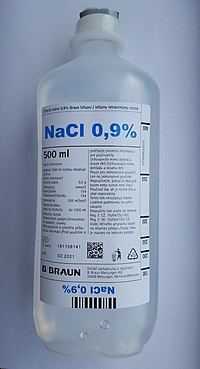
Photo from wikipedia
Nowadays, most of the commonly used superabsorbent polymers (SAPs) are derived from synthetic polymers, particularly acrylic acid and its copolymers made with acrylamide. Here, we describe a novel and environmentally… Click to show full abstract
Nowadays, most of the commonly used superabsorbent polymers (SAPs) are derived from synthetic polymers, particularly acrylic acid and its copolymers made with acrylamide. Here, we describe a novel and environmentally friendly aqueous-based process for fabrication of a new, natural, cellulose-based SAP (hydrogel). In this two-step process, cellulose was first reacted with sodium monochloroacetate (MCA) to obtain carboxymethyl cellulose (CMC) and then cross-linked with epichlorohydrin (ECH). In distilled water (d-water), the water retention value (WRV) of the newly fabricated hydrogels reached 725 g d-water/g gel, which is significantly greater than any other commercially available superabsorbent cellulose-based material (WRV of 10–100 g/g) and comparable to the commercial synthetic (polyacrylate) SAP gels (WRV of up to 1000 g/g). In saline water (s-water; 0.9% NaCl), the maximum WRV attained was 118 g s-water/g gel, which exceeds more than 2-fold the WRV of commercial gels (40–50 g/g). Compositional analysis was carried out to determine the amount of carboxyl groups and average molecular mass, and the parameters for hydrogel preparation were optimized. The natural SAP was characterized using scanning electron microscopy (SEM), Fourier transform infrared spectroscopy (FTIR), and X-ray diffraction (XRD). The hydrogels showed good re-swelling properties losing only 5–10% of their capabilities to reabsorb d-water when reused in four consecutive cycles. Because of their superior swelling properties in physiological saline, the new hydrogels can compete with their synthetic counterparts in applications such as high-value hygiene and biomedical products.
Journal Title: ACS Omega
Year Published: 2019
Link to full text (if available)
Share on Social Media: Sign Up to like & get
recommendations!